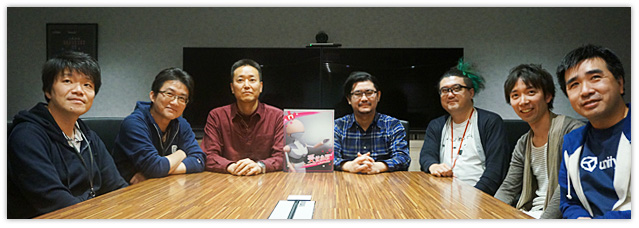
Our sixth development episode is divided into two articles that delve into behind-the-scene stories from the development of BANDAI NAMCO Studio’s smartphone game THE IDOLM@STER MILLION LIVE! THEATER DAYS (hereafter “MLTD”).
THE IDOLM@STER (hereafter “Imas”) is a series of idol producer simulation games created by BANDAI NAMCO Entertainment Inc. It originated as a 2005 arcade game, and has amassed a wide following for its game system in which the player nurtures rising idol groups as a producer, and for its unique characters and music.
So far, we have offered a variety of cross-media projects, ranging from console games, radio programs, TV animation series, mobile content, and even stage events.
This interview is brought to you by Uketsuke Komachi, a robot receptionist who has been working the reception desk for over thirty years.
THE IDOLM@STER MILLION LIVE! THEATER DAYS Project team
| Takahiro Kakizawa | Game Designer/MLTD Planning Development Producer |
|---|---|
| Kentaro Tsuchihama | Game Designer/MLTD Planning Development Director |
| Kiyotaka Tamiya | Designer/MLTD Art Director |
| Hayato Ikeda | Program Engineer/MLTD Client Program Leader |
| Takafumi Sato | Sound Designer Composer/MLTD Sound Director |
| Yoshito Higashi | Game Designer/MLTD Content Director, Script Supervisor |
| Kenichiro Kubo | Game Designer/MLTD Live Show Director |
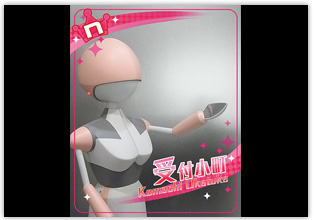
■Uketsuke-Komachi
Today, I would like to ask about MLTD. The game is distributed by BANDAI NAMCO Entertainment Inc. (hereafter “BNE”), and I hear that development was handled by BANDAI NAMCO Studios Inc.
●Tsuchihama: MLTD is an idol performance and producer simulation game for smartphones, which features both rhythm game elements in the 765 Production live theater and producer simulation elements in which you interact with idols and watch them grow.
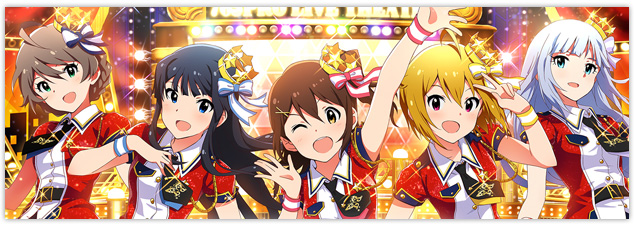
©BANDAI NAMCO Entertainment Inc.
【What is THE IDOLM@STER MILLION LIVE! THEATER DAYS?】
Do you want to see idols shine even brighter?
Imas puts you in the position of producer for the idol group 765 Million All Stars at the talent agency 765 Production. It’s your job to lead the group to the top of the idol industry!
Communicate with this group of unique of individuals in the theater, watch them perform on stage, and help them with a variety of jobs, all to find out just what makes each idol charming while you watch them grow.
Open up the game app to check out the inside of the theater where the agency’s fifty-two idols absently pass their time, which is displayed on your phone in 3D, and is brimming with small daily changes. You can start up a conversation with the idols inside the theater at any time and from any place, just by starting up the app.
Some days you’ll humor their whimsical, mundane conversations, while on others, the girls will come up with suggestions to discuss with you, they even text you to reveal their personal concerns or insecurities. By clearing up the girls’ concerns about their various jobs, or by cheering them on when they need it, your conversations with each idol tells a story of how the group faces conflict and learns from their experiences.
In live mode, you can select your five favorite idols to perform, and pick out cute costumes and songs to make them shine their brightest on stage. Find the song’s rhythm and tap along with the beat to lead the group from the beginning to the end of the song and clear the stage! Watch the full-3DCG idols pull off spectacular performances by singing and dancing while basking in cheers from the audience and the light of countless glow sticks.
Step into the shoes of the producer, and experience what it feels like to help girls achieve their dreams of becoming a shining star on stage!
■Komachi: Firstly, what did you put the most effort into when making MLTD?
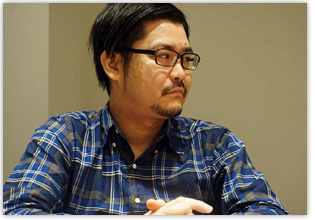
●Kentaro Tsuchihama
Game Designer/MLTD Planning Development Director
●Tsuchihama: We strived to create music that makes it easy for first-time Imas players to grasp what so many people find charming about the idols, and to use these songs in the rhythm game sequences. Also, to make the game interesting for returning players, we paid special attention during development to creating casual interactions with idols at the theater, and to creating dialogue that presents the idols’ personal feelings.
MLTD’s New Approach to Making Idols’ Lives Feel Synchronized with Your Own
●Sato: I remember I got so excited when I heard that we would make a smartphone application, because it’s a chance to make a game that showcases a lot of the songs we made in the past! The advantage of smartphone apps is that you take them wherever you go. Since you can take the idols anywhere, you feel like you can interact with them and help produce them at any time. In that sense, I feel that MLTD did a great job expressing Imas’ charm and approach in a new format. And being able to synchronize in-game content with real-life events is a lot of fun.
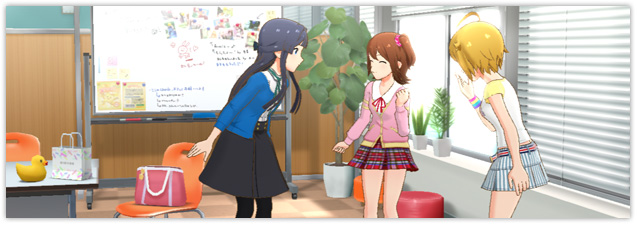
©BANDAI NAMCO Entertainment Inc.
■Komachi: You’re talking about the HotchPotch Festival, the live event performed by the cast in the Nippon Budokan, right? The moment the real show ends, the game’s secretary, Misaki-chan, announces in the app that the show’s over, which leads into a communication event where players interact with the idols. I think that synchronizing in-game and real world events provides players with a new way to experience performances; one which is a step ahead of previous games and feels very progressive, if not even futuristic.
●Kubo: Exactly. Making it was very rewarding for us, and it delighted a lot of fans.
■Komachi: And you offered tie-ups with a lot of different companies, too.
●Higashi: When a tie-up starts, you get texts from the idols saying things like, “I’m working at a beef bowl shop now, and they made me their poster girl!” Or “I did a photo shoot today for stickers that are going to be distributed!” One of the advantages of LiveOps smartphone games is that you can create content that is linked with real-world events and, deliver that content to the user immediately. MLTD makes good use of this feature by delivering it in a way that fits naturally into the game.
●Sato: It really makes you feel like the idols’ lives are synchronized with your own, and that they’re nearby you.
●Kubo: Of course, developing this type of game is not easy. We have to step out during performances to update contents, and live TV shows broadcasts are always hectic, because we perform updates behind the scenes as the show progresses. You feel that you are developing the game in real time.
●Tsuchihama: We pay special attention to making the in-game contents look different every day. Whether it be giving the idols a different outfit than normal in loading screens, replacing posters in the theater with the cover art of a new song, displaying messages on the whiteboard celebrating an idol’s birthday or drawings that match the current season, we try to include some small, new changes every day. These little details are another way that we strive to make the game feel like it’s operating in real time.
■Komachi: Compared with arcade or console games, a characteristic of smartphone games is that you receive instantaneous reactions to those updates from players, isn’t it?
●Tsuchihama: In MLTD, we put considerable emphasis on including fans’ opinions in the game’s content. We don’t want to release content one-sidedly, but to set our goals and what we want to do as the development team based on valuable comments from fans. We created plans for improving user-friendliness and convenience which are at the top of our priorities, and we plan to continuously implement these types of updates in-game as quickly as possible.
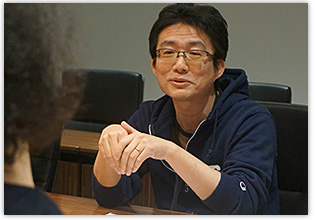
●Yoshito Higashi
Game Designer/MLTD Content Director, Script Supervisor
●Higashi: Imas is a series that has maintained a very close relationship with its fans since its inception. Going to live events gives us the chance to see fans up-close and to hear the enthusiastic voices of thousands of producers, which is an environment that we are grateful for as developers. When making console games, we receive reactions after a game is released and implement those opinions in the sequel, but creating smartphone games allows us to implement changes in a much quicker cycle.
●Kakizawa: The same goes for the live parts. We are constantly listening to fans’ opinions, and while the part usually looks the same, we make improvements to it on a daily basis.
■Komachi: In Imas players are called producers, and those producers create idols (icons). MLTD is a LiveOps game created by producers’ actions, but the relationship between the producers and the game is ultimately a collaboration between the feedback we get from fans and the contents that we developers provide, and I think that is a really amazing relationship!
Experience THE IDOLM@STER at its best even on a smartphone!
■Komachi: With so many events and things to improve, isn’t it hard work for all of you to meet all of these demands?
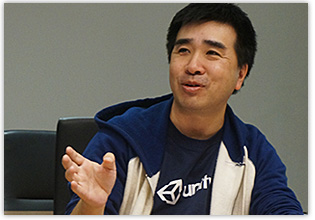
●Hayato Ikeda
Program Engineer/MLTD Client Program Leader
●Ikeda: LiveOps titles like MLTD periodically hold events and add new content, so we try to automate as much of the game as we can. On the other hand, we make a point of setting aside engineer resources so they can innovate and take the game in the direction they want to take it. This is all done out of our desire to make the game as good as it can be.
●Tamiya: I think the art team makes more extravagant requests to engineers than the planning team…
●Ikeda: The biggest challenge we ran into at the beginning of development was bringing the five-member formation dance (*1) from the console version to smartphone. As soon as we reached a point where all five idols could do different dance motions and the game looked like it would work on smartphones, we received request after request to separate each member’s vocals by giving five vocal parts for each member. We would discuss as a team and decide, for this request, we’ll give you this much! Or sometimes we’d be told, we absolutely need this feature! By brainstorming good additions as a team, MLTD turned into the game it is now. Every part of the team, not just engineers, but also visual artists, planning staff, motion artists, and sound designers, all strongly felt that we wanted to make something even better than what had been made until now. Making it wasn’t easy, but as a result we received a lot of positive feedback about the game, which makes creating the game worth the effort.
*1: Five-member formation dance, separating member’s vocals:
In the Imas console game series, idols will sing or dance different parts by changing members or the positions that they stand on stage. In MLTD, you can select five out of fifty-two idols and them each different parts. Songs with the “separated vocals” mark can be combined into more than three hundred million vocal part combinations.
●Higashi: We’ve discussed all of these things we can accomplish because we’re making a game for smartphones, but I think it’s also amazing that a smartphone can accomplish almost the same things as a console.
●Kubo: Everyone on the team is very passionate. When I say “Let’s make this game good!” everyone responds “Let’s make it happen!” I felt that during production, there was a gradual increase in staff who would cordially respond to my suggestions to add new things to the game by saying, OK, this is what we have to do to make that a reality.
●Sato: And you’re the most passionate one on the team! You always come up with new ideas to add to the game, and end discussions saying, “Let’s do it!” It’s been that way the entire project. (Laughs)
●Kubo: I consider myself first and foremost an Imas fan. I try to guess how fans of the series would feel about the game. So instead of trying to find a new spin on an existing idea, I try to imagine the qualities of Imas that fans have cherished for over ten years, or expressions that fit the series perfectly, and to relay those to the staff.
●Ikeda: For example, in a scenario event part called “communication” where idols chat with the player and each other, to create acting in this sequence, we made a scripting making tool from scratch that’s comparable to that in the console games. Our script writers add 3D acting and facial expressions to match the dialogue, which they tweak to look irresistibly cute.
●Kubo: Creating a working environment is an important part of making a good game. For live mode, we spent a good amount of time creating a music score tool that places notes in the game. This tool makes use of the dozens of years of know-how accumulated from work on Taiko no Tatsujin, and we had to beg them to let us use it, saying it’s a must for this project!
Reproducing Performance Spaces with an Uncompromising Attention to Detail
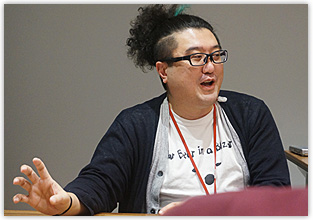
●Kenichiro Kubo
Game Designer/MLTD Live Show Director
●Kubo: There are two major parts in live mode. The first is admiring idols shine their brightest on stage, in other words simply enjoying watching them perform. The second is playing the rhythm game and enjoying playing along with the song. As developers, we want you to enjoy both simultaneously, and this has been a major undertaking for us since the beginning. However, one of the major goals in MLTD is linking the idol’s dance moves (on screen) and the user’s inputs. I think many rhythm games’ development teams are often split into a group that make visuals and a group that make the rhythm game itself, but for MLTD I oversee both teams together. We have a lot of great songs created by a variety of artists, starting with those from Lantis (*2) and Sato-kun. These songs are also the base for the idols’ dances, as well as the rhythm game, and all of these elements come together in live mode! That’s the way I try to fit together the different pieces of this game.
*2:Lantis
A music publishing label that produces many of the songs sung by the idols in MLTD.
■Komachi: In MLTD, it sounds like everything from the songs, dances, and the feel of the stage all combine to make a musical score that links with the performance! That’s really new. When the song transitions to the chorus and the audience gets going, when your inputs synchronize perfectly with the idols’ dance moves, you feel like you’re a part of the audience and the performance, and that sense of synchrony is an awesome feeling.
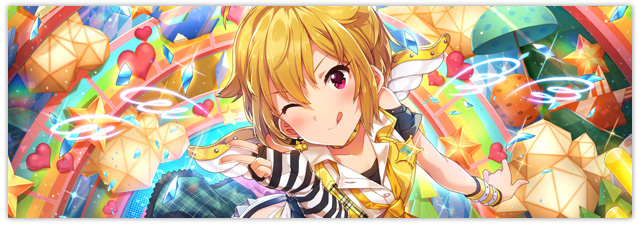
©BANDAI NAMCO Entertainment Inc.
●Kubo: We hold meetings twice a month to talk about directing live performances, and we call the meeting the “Greatness Checkup Meeting.” We check how great the performance is, and whether it’s better than it was last month. We reference a phrase the cast said during a live event, that “you have to always set a higher bar for greatness,” and try keep the meeting passionate so we can continue to raise the bar we set for ourselves.
●Tsuchihama: And one of the unforgettable parts of live mode is the moving glow sticks! We always pay an unbelievable amount of attention to them. But we always leave that up to the Director, Mr. Kubo. (Laughs)
●Kakizawa: Mr. Kubo, you have a deep understanding of how producers in the audience cheer on idols, but could you talk about what parts of live shows you pay attention to?
●Kubo: Glow sticks are a way of paying respect to the actual live scene. Fans all have their own ways of cheering with glow sticks, and the way they’re used is constantly evolving. I try to go to ask many Imas concerts as I can to gather information, but I spend more than half of the concert looking at the audience. Watching them, I realize they’re really into one part, but I haven’t seen this cheer before. I try to observe what cheers change between concerts, and implement those changes in the game.
●Ikeda: From a technical standpoint, making glow sticks move is pretty tough. We made additions to the editor to make it easier for their movement to look good after cutting to a short shot, or to give more freedom of movement to adapt to changes in types of songs or cheers.
●Kubo: We don’t perfectly trace glow sticks’ movements, but observe fans’ feelings when they are cheering, or to what parts they react to the strongest. Once we understand this, we reflect it in the lights’ movements and the audience’s cheers.
●Tamiya: Some of MTLD’ s visual staff also have experience working on console games, and the way all of the members’ experiences and preferences come together is great. You can see this in the characters, backgrounds, camera, and motions; watching the camerawork, staging, and the way the characters’ bodies and hair moves on the stage feels great.
●Kubo: If one section has to cut corners, that part won’t end up on camera. If the audience moves like robots, we can’t use shots that show them on screen for long. Because of this, I really feel that every section, from character and background design to motion creation, camera work, sound creation, engineering and planning, all work hard to do the best work they can.
●Sato: The camerawork especially moves in ways that would be impossible to pull off in reality. This type of expression has a level of impact that you can only see in games that surpasses the limits of a real camera, which I think is really impressive!
●Higashi: And there are a lot of people who have never been to an actual idol performance. The game gives them a chance to see what these events actually look like by recreating the audience cheering on the idols in-game. This gives these players a chance to experience what it feels like to be a part of these events, and I think we were able to create a performance that’s passionate enough that it might make potential fans want to go to a real performance.
●Tsuchihama: One thing we talked about at the beginning of development was that, even if playing the app makes new fans of the series, the ultimate goal of the experience is to have players enjoy a real performance. This is the concept behind this content, so we asked our staff to make expressions in the live part as high quality as you would see in a real live performance. We were blown away when we saw their final output, I really felt that the entire team is excited about what we’re making.
●Kakizawa: The MLTD project mixes a variety of media by tying in things like real live events and music publishing, and I think that allows us to make the most of the fact that we are making a game for a BANDAI NAMCO Group IP.
●Sato: We’ve been discussing with BNE and Lantis about expanding outside the game, and using songs that explore character’s and unit’s personalities in CDs or performances, which is all to make Imas as good a series as it can be. I think one of the strengths of the BANDAI NAMCO Group is that we are able to create mixed-media projects that expand outside the realms of the game!
THE IDOLM@STER
Product of BANDAI NAMCO Entertainment Inc.
©Toshiyuki Kubooka ©BANDAI NAMCO Entertainment Inc.
THE IDOLM@STER MILLION LIVE! THEATER DAYS
Produce the idol group 765 Million All Stars in the 765 Pro Live Theater! Be it during performances on stage, at work, or by communication in the theater, the game is packed with chances to interact with idols!
Official site
https://millionlive.idolmaster.jp/theaterdays/
Distributer:BANDAI NAMCO Entertainment Inc.
ⒸToshiyuki Kubooka ⒸBANDAI NAMCO Entertainment Inc.




